Runnin’ Down a Dream
There’s something to be said for playing the contrarian. That’s not to say conventional wisdom should be defied at every turn (I’m reminded of the Dave Chappelle sketch, “When Keeping it Real Goes Wrong”), as that can be every bit as inflexible as falling in line with those rigidly adhering to the norm. But, zigging while other zag can help dynasty owners find value where they may previously not have looked.
My recent contrarian take would’ve actually been the Stepford Wife of dynasty strategies as recently as five to six years ago. But now, when it comes to selecting running backs early and often, that approach has gone the way of the afternoon paper. The dynasty universe is run by wide receivers and those who love them, and even with the incredible ball carrier performances in 2016, it doesn’t appear to be changing.
To that last sentence, however, I see something more. I previously wrote about exactly what made these young, stud running backs so special, and why we should consider selecting them early in drafts. Taking it one step further, I even advocated for taking Cardinals running back David Johnson as the 1.01 in dynasty startups.
Unfortunately, I’m still a salmon swimming upstream, with the wide receiver loving bears swatting at me and my ilk with the casual indifference of Bill Belichick discarding a reporter’s question. Their newest argument has centered around why members of the robust ball carrying crop of 2017 shouldn’t be selected with high, first round picks, laughably using Zeke Elliott as the example as to why this is bad practice. Yes, the same Zeke Elliott who led the league in rushing as a rookie, scoring 16 total touchdowns and averaging 5.1 YPC in the process – because somehow we just know that if it was Derrick Henry in the second round, things would’ve magically turned out the exact same way.
Naturally, this led to the companion argument that running backs either bust at a higher rate than receivers, or they get hurt and fall out of the league altogether. Continuing, it’s also easy to find backfield “diamonds in the rough” in the later rounds, and as such there’s no reason to spend a high pick at the position. It’s these exact arguments that I want to focus my energies on.
[am4show have=’g1;’ guest_error=’sub_message’ user_error=’sub_message’ ]
I went back and analyzed all the running back and wide receiver draft picks of the past five years (H/T to Pro Football Reference for streamlining the searchability), in order to clarify the hypotheses above. Is it really foolhardy to select a running back early when talented wide receivers are available? Is it more likely your dynasty team (along with an NFL team, as real-life and fantasy numbers are obviously intertwined) will prosper if you wait until later in the draft to pick a ball carrier? Are the bust rates at the positions diametrically different?
In order to do this, I broke down the player pools into two zones at each position – those who were selected in the first three rounds of the draft, and those who were picked between rounds four and seven. To me, a selection in the first three rounds represents significant draft capital (it’s no surprise these are the rounds covered in the first two days of each NFL Draft), whereas round four or later become more of dart throw, luxury picks. You can argue the subjectivity of this delineation, but “top half” versus “back half” (insomuch as you can have halves with an odd number of rounds) distinctions seem fair to me.
From there, I graded every player and distinguished each with one of seven categorical labels: Stud, Starter, Rosterable/Spot Starter (R/SS), To Be Determined (TBD), Bust, Injury/Off-Field Concerns, and Other. The color coding for these assignments is shown in the table below, and it’s my belief both fantasy and NFL values align in a roughly similar manner.
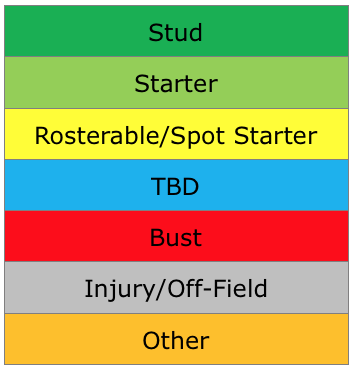
Again, the objectivity of these measures can certainly be scrutinized. In the interest of full disclosure I took a conservative tack (i.e. I’m more likely to downgrade rather than upgrade), and focused on actual on-field performance as opposed to dynasty value. Some other notes about the grading process:
- Yes, I’m conservative. You have to really earn Stud status in my book. Todd Gurley isn’t recognized as a stud because he played like hot garbage last year (despite still finishing as an RB2). Ditto Allen Robinson. Again, we’re talking NFL performance, not ADP.
- A TBD designation was reserved for two classes of players. 2016 rookies who really didn’t get a chance to show what they can do, and players with a high variance between potential stud and possible bust (ex. Derrick Henry, Kevin White, Laquon Treadwell). It seemed disingenuous to place any different label on such players, when we simply don’t know what they’re capable of.
- Bust status could be bestowed on both players who have been in the league for four to five years, or also those who have clearly done nothing in a short period of time. For example, I have no hesitation labeling Nelson Agholor as a bust, as he’s likely to be the WR5 for the Eagles this season. I also consider players such as Kendall Wright and Michael Floyd busts, as they haven’t shown anything recently, and landing in a new location doesn’t give them the benefit of the doubt as a TBD player. I believe we know what we need to know.
- Injury/Off-Field Concern players are as they sound. They’re either out of the league for either reason, or never established a semblance of continuity for the same explanation (think Bruce Ellington or DeAndre Smelter). However, as much as I wanted to shoehorn players like Josh Gordon and Martavis Bryant into this category, as even though they’re “rosterable” we don’t know if they’ll ever play again, I classified them as TBD.
- Players branded with the “Other” label are those who were drafted at one position and moved to another.
Let’s get onto the lists, starting with the Round 1-3 running backs:
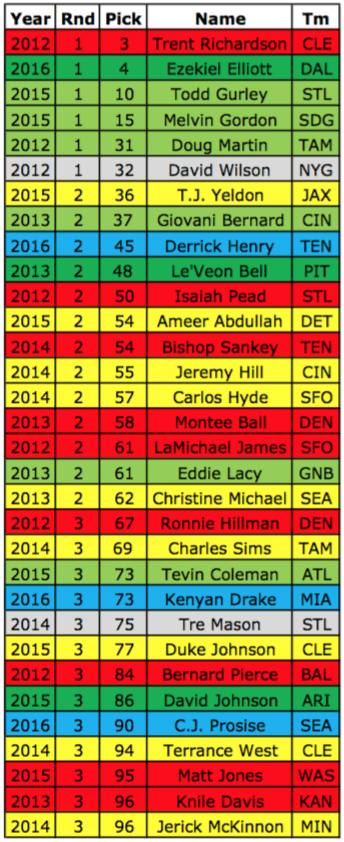
Next, let’s consider the Round 1-3 wide receivers:
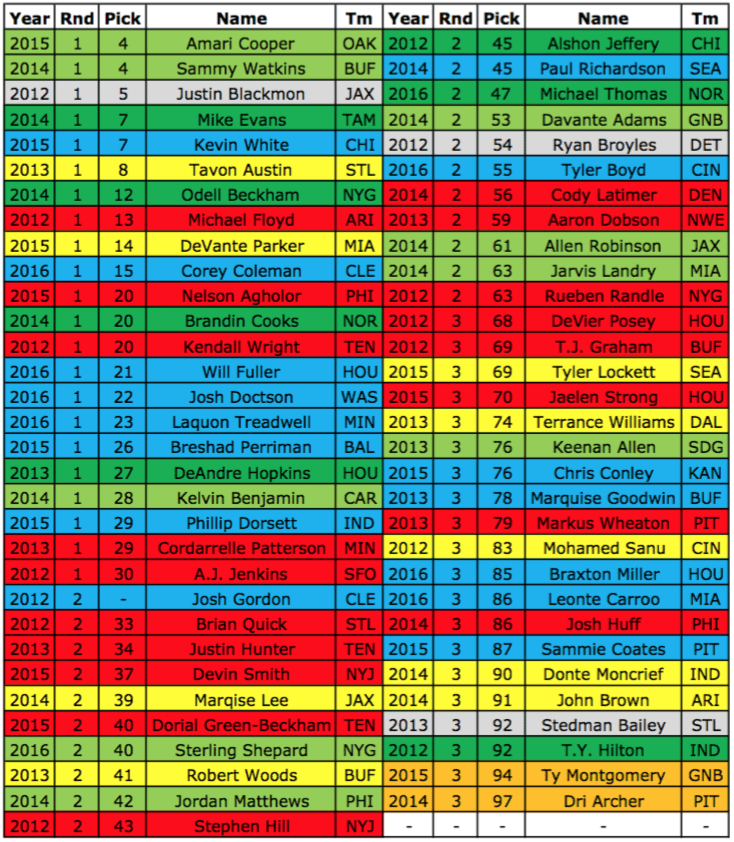
Continuing, here are the Round 4-7 running backs:
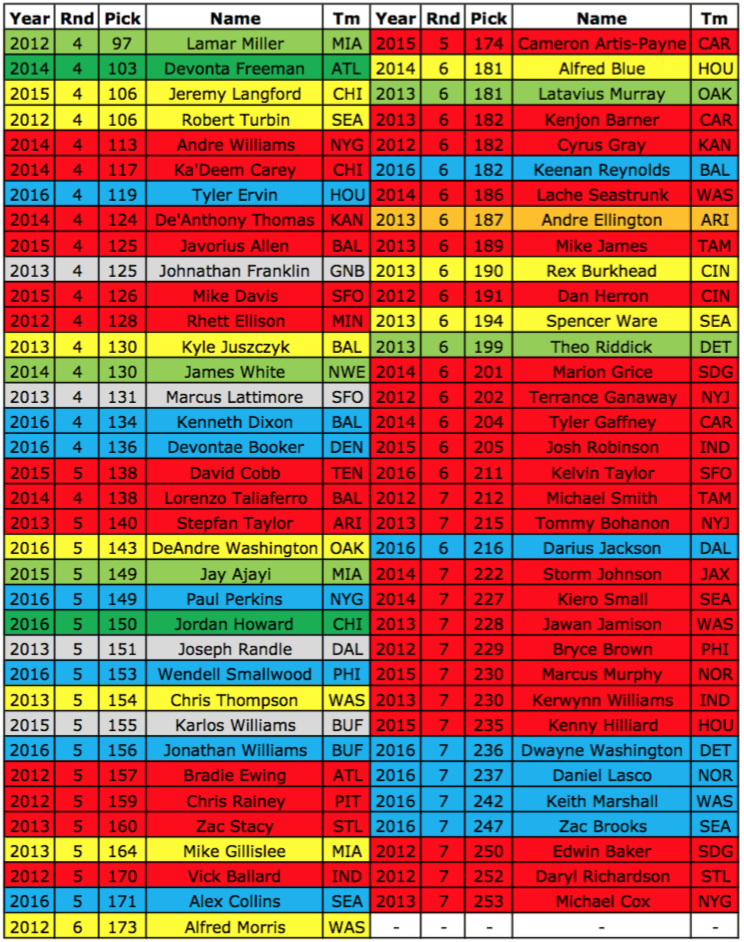
Finally, let’s conclude with the Round 4-7 wide receivers:
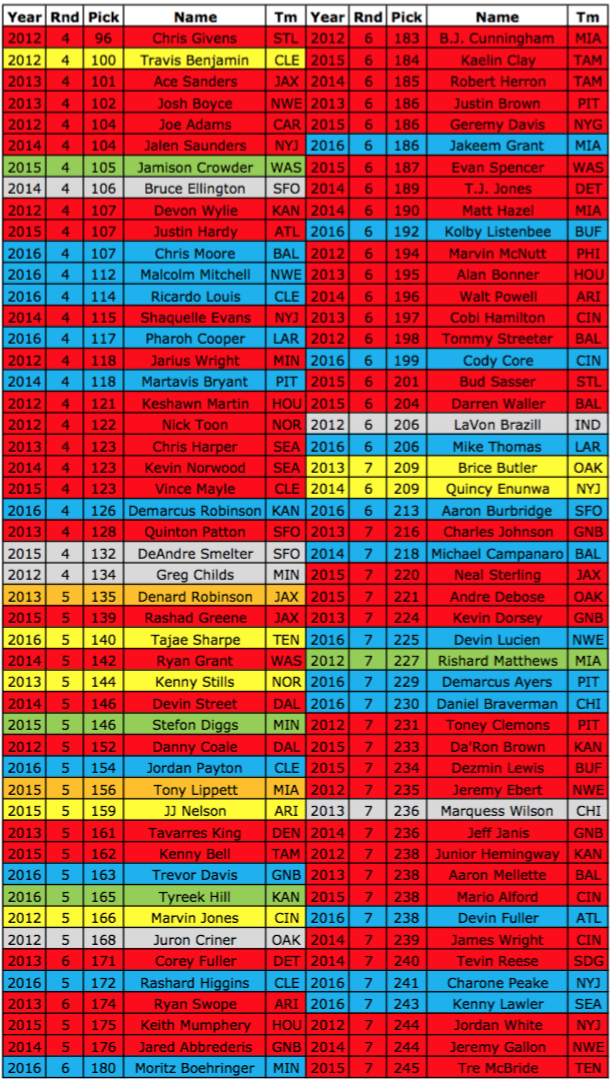
That’s a lot of names, and kudos to all of you who read through each and every classification! So what did we yield by sifting through all this muck? The table below summarizes the overall ranking system nicely.

Before I present my conclusions, some considerations need to be taken into account when pondering the data above. First, percentages were achieved by dividing the number of players in each category by the total number of players in the zone, not including those designated Other. Second, while TBD players were included in the denominator for each calculation, I didn’t tabulate a percentage for that zone as I don’t believe it provides any sort of insight. Finally, the Injury/Off-Field players are considered as a subset of Bust players, and are included in the Bust zone percentages. While it’s fair to argue failure wasn’t necessarily their fault, the fact remains they didn’t contribute in an NFL or fantasy sense.
With that explanation in hand, the following can be resolved:
- There’s precious little difference in the Stud percentages for R1-3 running backs and receivers: The receivers take the day by 2.1%, but the chasm isn’t nearly what many make it out to be. Perhaps perception is tainted because…
- There’s a greater volume of Stud receivers relative to the running backs: With seven Stud receivers compared to three Stud running backs, it’s easy to discern why many believe it’s a better position to draft. Of course, the subset of R1-3 ball carriers only stood at 32 players, while there were 61 such pass catchers (factoring out the Others). It’s fair to argue this could be the NFL trying to tell us something, but I believe it’s more likely that, in a standard offensive formation, there are two to three receivers per every one running back. Still…
- You’re more likely to get rosterable and startable assets in early round running backs than you are with wide receivers: The running backs won the day with percentage of Starters by 4.0%, and nearly doubled the receivers in the R/SS zone. All told, when combining Stud through R/SS (rightmost column), you were 15.2% more likely to obtain players who will, at worst, deserve inclusion on your roster.
- The myth about Busts is busted: Amazingly, the percentage of Busts for R1-3 running backs and receivers was exactly the same at 34.4% apiece. There were also high-profile busts at each position (Trent Richardson, meet Justin Blackmon), and actually a greater number of Round One Busts on the receiver side. You can still feel free to use the longevity argument if you want, but as has been my belief all along, there are early Busts at every position!
- There IS something to be said for a late–round running back strategy: Don’t get me wrong, the notion of back-loading your roster with late-round fliers is beyond romanticized, as only 24.2% of the R4-7 ball carriers were found to be rosterable. Still, there were a duo of studs (Devonta Freeman and Jordan Howard) in the mix, with some Starters thrown in as well. All told, the Stud through R/SS percentage for running backs nearly doubled that of the wide receivers, and there wasn’t a Stud to be found in the latter group.
- But but but…Injuries!: Only two of 32 R1-3 running backs busted due to Injury/Off-Field concerns, compared to three at receiver. Don’t let risk of injury and character concern steer you away from picking a ball carrier early.
- There remains more uncertainty at receiver: Of the 32 R1-3 running backs, I only classified three in the TBD zone. At receiver, I pigeonholed 15 such players. This could, in theory, go a long way towards changing the numbers above, but when I look at the group I actually see more players likely to bust than I do future Studs. There are some potential Starters and R/SS guys in the mix, but I won’t be surprised if and when these numbers don’t reflect positively for the pass catchers in the coming years.
While I’ll be the first to admit this is an inexact science, I do believe there’s enough evidence above supporting that the malice exhibited towards the running back position is unfounded at best, and uninformed at worst. We’re all free to build our teams as we wish, but the notion that it just makes sense to construct a roster around receivers doesn’t hold water to me. The theoretical (this is an important distinction) longevity argument is real for the cream of the crop, but on average you’re not getting 10+ years of Stud performance out of anyone, and I’m still in the camp that it’s farcical to believe we can predict the future more than a few years in advance. So in the spirit of quoting Tom Petty in the title of this article, I believe it’s prudent to remember that when you’re assembling your roster, there are just as many Heartbreakers out there at the wide receiver position.
Follow me on Twitter @EDH_27
[/am4show]
- Dynasty Fantasy Football Mailbag: Justin Jefferson Or A Bundle Of Draft Picks? - April 23, 2024
- Dynasty Fantasy Football Mailbag: Is Kendre Miller Valued Unfairly? - April 17, 2024
- Forgotten Dynasty Veterans: Bottom Tier - April 9, 2024


































































